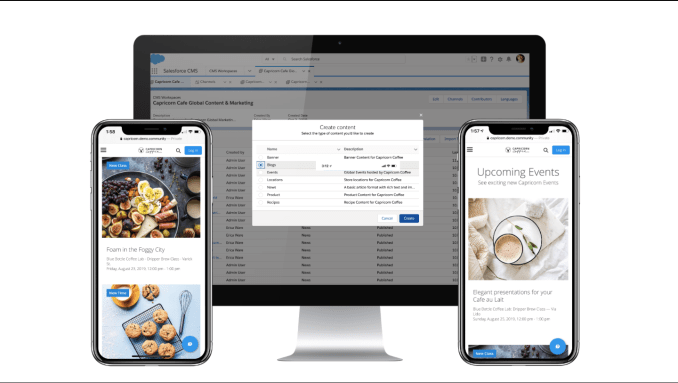Salesforce has its fingers in a lot of parts of the customer experience, so why not content management? Today, the company announced a brand new tool called Salesforce Content Management System, which it says is designed from the ground up to deliver a quality customer experience across multiple channels.
The idea is to provide a way for customers to create, manage and deliver more meaningful content across multiple channels from within the Salesforce family of products. The company claims it doesn’t require any kind of deep technical knowledge to do it, meaning marketers and product people should be able to create and deliver content without the help of IT, once the system is properly set up.
Anna Rosenman, Salesforce’s VP of product marketing for Community Cloud, Commerce Cloud and Salesforce CMS says the company created the new CMS to answer a customer demand. “Our customers have been asking for a dedicated CMS. The systems that they’ve been relying on so far tend to be legacy tools that are hard to use and built for a single-channel or site,” she said.

Photo: Salesforce
While users can create more personalized content based on what they know about the customer based on Salesforce data, Rosenman says the key differentiator here is the ability to connect to third-party systems. “A hybrid CMS provides a native experience channel or touchpoint, but also gives you the flexibility to present content to any touchpoint built on a third-party system,” she explained.
Tony Byrne, founder and principal analyst at Real Story Group, who has followed the Web CMS space for two decades, says this isn’t the first time that Salesforce has tried content management. The previous iteration was called Salesforce Sites. “They made big promises around that platform, got some major customers on board and then dropped it,” Byrne said.
He says that because it’s a major challenge to build a sophisticated multi-channel CMS. “It’s easy to build a simple CMS. It’s much harder to build an extensible, enterprise platform,” he said. He added, “There’s a lot of work they still need to do to feed other platforms around things like connectors, simulation, tracking, very advanced asset management (e.g., compound assets), object-oriented storage, etc.”
But Rosenman says that the system’s built-in flexibility is designed to provide that, and even be used in conjunction with existing legacy tools if need be.
What’s interesting here is that Salesforce decided to build this tool, rather than buying a company and integrating it into the Salesforce family, an approach it has not been afraid to take in the past. In fact, the company pursues an aggressive acquisition strategy. This year alone it spent more than $15 billion to buy Tableau and another $1.35 billion to buy ClickSoftware.
In this case, in the tension between building and buying, it decided to build instead. Time will tell if that was a good decision or not.
